Hyperbaric oxygen therapy shows promise in treating opioid addiction
- Normal Liver Cells Found to Promote Cancer Metastasis to the Liver
- Nearly 80% Complete Remission: Breakthrough in ADC Anti-Tumor Treatment
- Vaccination Against Common Diseases May Prevent Dementia!
- New Alzheimer’s Disease (AD) Diagnosis and Staging Criteria
- Breakthrough in Alzheimer’s Disease: New Nasal Spray Halts Cognitive Decline by Targeting Toxic Protein
- Can the Tap Water at the Paris Olympics be Drunk Directly?
Hyperbaric oxygen therapy shows promise in treating opioid addiction
- Should China be held legally responsible for the US’s $18 trillion COVID losses?
- CT Radiation Exposure Linked to Blood Cancer in Children and Adolescents
- FDA has mandated a top-level black box warning for all marketed CAR-T therapies
- Can people with high blood pressure eat peanuts?
- What is the difference between dopamine and dobutamine?
- How long can the patient live after heart stent surgery?
Hyperbaric oxygen therapy shows promise in treating opioid addiction.
Hyperbaric oxygen therapy may help people treated for opioid addiction reduce their doses of methadone, the alternative drug, and better manage pain and withdrawal symptoms, according to a pair of studies led by Washington State University scientists.
The research team recruited participants in a local opioid treatment program to test the effects of hyperbaric oxygen therapy, which involves breathing pure oxygen in a pressurized environment.

The first paper, published in the Journal of Addiction Care, describes a pilot study of 31 participants showing that those who received hyperbaric oxygen therapy as part of a planned methadone reduction Significant reductions of 4.3 mg were maintained for three months after the study ended, compared with 0.25 mg for participants who did not receive the treatment.
They also reported that after just one day of hyperbaric oxygen therapy, participants in the control group experienced half the level of withdrawal symptoms.
“While methadone helps opioid addicts gain stability and return to normal life, it’s still an opioid they take every day,” said study co-author, WSU Elson S. Floyd School of Medicine professor and former said Matthew Layton, medical director of the Opioid Treatment Program. “About half of the therapists wanted to wean off methadone for a variety of reasons, yet many who tried failed and relapsed. Our findings suggest that hyperbaric oxygen therapy has the potential to be used as a nonpharmacological tool to help People are phasing out methadone therapy.”
The second study, published in Pain Management Nursing, was a small randomized controlled trial with eight participants that looked more closely at the relief of withdrawal symptoms.
The study found that participants in the hyperbaric oxygen treatment group reported lower pain intensity and drug cravings than participants in the control group, who received an oxygen mixture equivalent to room air at normal atmospheric pressure. The researchers also saw improvements in other outcomes, such as sleep quality and mood.
“While for some, the challenge is weaning off methadone, others struggle to stay on treatment at an early stage, as finding the appropriate Dosing to stabilize symptoms can be difficult to achieve. As a result, many people experience withdrawal symptoms during that adjustment period that are severe enough to cause them to resume illicit drug use or drop treatment.”
Based on the collective findings of the two studies, the researchers are seeking funding for a clinical trial to confirm their findings in a larger sample of participants who will be followed for several years.
The idea for these two studies came from earlier work by WSU researchers showing that hyperbaric oxygen therapy can relieve pain and reduce physical symptoms of opioid withdrawal in mice.
“We were eager to see if it could work in people,” said study co-author Raymond Quock, a professor in WSU’s College of Arts and Sciences who led the work.
If their findings are confirmed in a larger clinical trial, hyperbaric oxygen therapy could become a non-drug tool that medical institutions can use to help people manage their pain and potentially reduce their opioid use.
“Last year, within the confines of the COVID-19 pandemic, more than 100,000 people died from the opioid epidemic,” Layton said. “This shows us that opioid addiction is still a very big problem and we need to have better ways to deal with it.”
Hyperbaric oxygen therapy shows promise in treating opioid addiction.
(source:internet, reference only)
Disclaimer of medicaltrend.org
Important Note: The information provided is for informational purposes only and should not be considered as medical advice.



